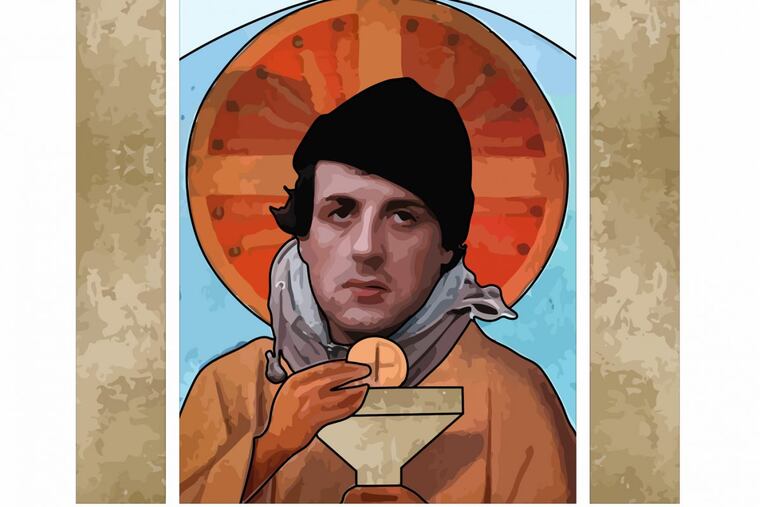'Rocky' as art: Philly gallery explores Italian Stallion in new show
Creed II is filming in Philly, while a Queen Village gallery plays tribute to the Italian Stallion

Creed II officially kicked off filming in Philadelphia earlier this month, bringing Rocky Balboa himself, Sylvester Stallone, back to the city for the Rocky franchise's eighth installment. Sly even stopped by the old Rocky statue at the Philadelphia Museum of Art for a hit of nostalgia that Philly folks loved.
Across town at the Da Vinci Art Alliance (704 Catharine St.), however, organizers are taking a closer look at Philly's obsession with the Italian Stallion, as well as how we've changed since he debuted in 1976, with the new exhibit Rocky (re)Runs.
Running Wednesday to April 29, the exhibit focuses on Rocky's famed 30.61-mile run throughout Philadelphia in 1979's Rocky II, which took the boxer from South to North Philly and back again, and to several neighborhoods in between. Original pieces from about a dozen Philadelphia artists will be on display examining Rocky from artistic, academic, and architectural perspectives — standpoints not typically associated with the film's blue-collar, low-budget roots.
But don't expect a bunch of highfalutin paintings of the Art Museum steps, or simple shots of Center City now versus in the 1970s. Instead, Rocky (re)Runs presents the franchise from the perspective of the "hidden neighborhoods" Rocky passed through on his run, as well as the people who populate them, co-organizer John James Pron, professor emeritus of architecture at Temple University, says.
"We're not that interested in Chestnut Street, or the Parkway, or the staircase," Pron says. "We're talking about Philadelphia and Philadelphians more than Rocky himself."
In that way, Rocky offers a window into the hearts and minds of Philly's inhabitants, co-organizer Andrew Hart, an architecture professor at Jefferson University, says. The original film couldn't have been made anywhere else because "if you take Philadelphians out of the movie, you don't have Rocky."
"[The movie] puts together this visual map of Philly that isn't the helicopter shot coming down on City Hall," he says. "It's from the viewpoint of somebody on the sidewalk — it's the view we all have every day."
Rocky (re)Runs mirrors that personal experience through its artwork. Pron's piece, for example, is a large mosaic collage that details his family's history in Northern Liberties long before the days of Rocky, and focuses on family members the architect lost to suicide, drug abuse, and other issues. Like Rocky himself, Pron made it out of a potentially similar future, and now looks back on his old stomping grounds, which have since become one of the city's most gentrified neighborhoods.
"This is the area where my family and I ran from, while at the same time Rocky ran past it," Pron says. "He was able to deal with his problems. A lot of my family, their demons destroyed them. I will be threading the streets with my history."
"Adrian's Run" by D.S. Nicholas, director of design research at Drexel University's School of Architecture, Design, and Urbanism; and student Nick St. Angelo, on the other hand, examines Rocky from Adrian's perspective. In the piece, videos, 3D prints, and photos show off the imagined interiors of the South Philly homes the boxer ran by in his training montage as Rocky's wife may have thought of them. After all, as an artist statement puts it, Adrian is "the true force behind Rocky's run."
Another piece, "Rocky Stained," from designer Gabriella D'Angelo puts Rocky in a sacred light by recreating his image in the style of stained-glass windows, much like those that dot churches and homes throughout Philadelphia. Applied to the gallery's windows as a translucent vinyl sticker, D'Angelo's artwork comments on our idolization of Rocky in the face of the "conservative undercurrent" of the franchise.
The themes vary, but Rocky (re)Runs ties them together with a live map from Hart representing Rocky's training montage run. Known as a "datum," the piece runs around the DVAA's perimeter, and serves as a literal and conceptual connection point for the show, much like how Rocky connects Philadelphia to the rest of the world.
"When you tell people you're from Philadelphia, you have to tell them [where you live] in relation to the Rocky statue," he says. "It's the great datum that connects people in the city and people outside the city."
The show will also explore Rocky through events in addition to artwork. One, scheduled for April 26, features a Skype Q&A with sculptor A. Thomas Schomberg, who, in 1980, created the Rocky statue that is now outside the Art Museum. Schomberg, who lives in Colorado, also loaned the DVAA a bronze statuette of the official Rocky statue, which a talk will examine as art rather than a movie prop, Pron says.
Author and former Inquirer reporter Michael Vitez, meanwhile, will give a presentation on his 2006 book Rocky Stories: Tales of Love, Hope, and Happiness at America's Most Famous Steps, on April 29.
For all the Rocky obsession at the DVAA this month, though, not all the organizers are in love with the franchise. Hart, for his part, is a fan going back to childhood; Pron has never been able to make it all the way through a Rocky movie. But given the focus of the exhibit, he says, that shouldn't really matter.
"It has nothing to do with boxing. It has to do with certain classes of people," Pron says. "I'm not into boxing, but I'm into Philadelphia."